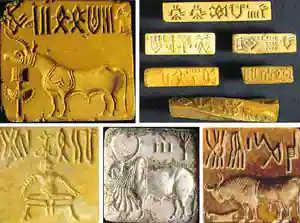
In 1958 a team of researchers led by F. A. Khan found some sort of evidences of the scripts used in ancient Sindh city of Bhanbhor. Unfortunately the volume of such evidence is too little to construct the entire script as it existed in ancient Sindh.
By Rakesh Lakhani
The search for any indigenous Brahmi based scripts often starts & terminates at Hat-Wanaki. This despite that fact that Sindhu-Saraswati civilization of Sindh had the very nucleus of not only Indus valley civilization but of Vedic civilization as well. Arabic author Al- Beruni in his writings on ancient Sindh did mention three scripts to be in vogue before the Arab invasion of Sindh viz. Malwari, Hinduvi and Ardhanagri. Yet confusion remains. One of the reasons of such confusion had been lack of historical evidences to counter verify the usage of Brahmised scripts in Sindh. In 1958 a team of researchers led by F. A. Khan did find some sort of evidences of the scripts used in ancient Sindh city of Bhanbhor which was approximately 40 Miles from the Sindh’s capital Karachi. Unfortunately the volume of such evidence is too little to construct the entire script as it existed in ancient Sindh. One of the main reasons needless to say had been the massive Arab Invasion of Sindh which swept all traces of Hindu culture. What Arabs destroyed never got rebuild in the context of Writing Systems in Sindh one can conveniently divide Sindh’s History in two parts. Viz. One before the Arab invasion and the other that followed after the massive upheaval that changed Sindh in all possible manner – culturally, socially and politically. Needless to say while almost all the North and West Indian Scripts could easily be traced to its Brahmi, Sindhi never been that much fortunate. A close analysis revels more than once reason for loss of Historical loss of archeological evidence viz. A) Post Arab Invasion there was a virtual slaughter of Sindhi Hindu Sadhus- the custodian of Learning in ancient India – Such void had a disastrous effect on Sindh which never could be reversed. B) Post Arab invention every attempt was made to wipe out Hindu civilization & Culture including language from Sindh; C) In Kashmir & Punjab where even Hindus regained power from Muslims, the contemporary rulers reintroduced Brahmi based scripts but in Sindh Post Dahir Hindus never to could settle themselves and even those who did settle themselves after accepting Islam never bothered to reintroduce Sindhi Language in Sindh leave apart the Brahmni scripts D) Ever since the massive Arab invasion Hindus were in a bitter struggle of existence. A struggle that continues even today in post-partition Sindh; E) Despite Sindhi Muslim pride for Mohen Jo Daro civilization there had been very few instances where they had been interested in preserving pre Islamic Hindu culture of Sindh. There had been a near unanimous consensus based on hard archaeological proofs that almost all of the scripts of South Asia including those of Indian subcontinent have their origin in Brahmi script. It had been conclusively proved that a gradual transformation did take place spanning thousands of years for the present day scripts to develop as they are today. The figure below depicts the most likely path that Brahmni took in Sindh, Punjab & Kashmir.
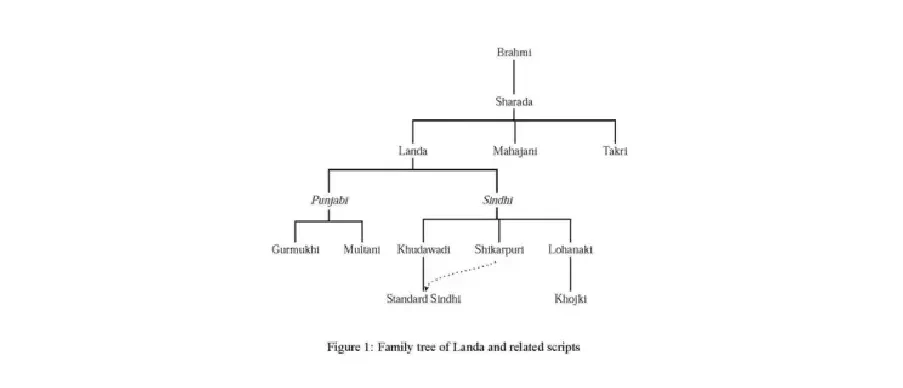
In the year 1958 a research team headed by Dr. F A Khan while looking for ancient civilization in Southern Sindh did traced some ancient script. Apart from this there had been very few traces which would clearly establish the link which would conclusively proves that path that Sindhi script might have taken to reach Waranki Script – A form of Landa scripts. Moreover there is still a mystery as how and when Brahmi in Sindh drifted towards Sharda script- The general belief is that the script of Ancient Kashmir Sharda is to be the mother of Northwestern Indo-Aryan Languages. In 1843 with the advent of British in Sindh, Sindhi Language got back it official status after 1500years of brutal Islamic rule. Among those westerners who worked on contemporary scripts were Garrison (Linguistic Survey Of India), Captain George Stack (Writer of Sindhi Grammar& Dictionary in Devanagari Script) and William Litnenar (1882) A collection of specimen of commercial and other Alphabets .The scripts that were in vogue at time of advent of British are as follows as collected by Garrison.
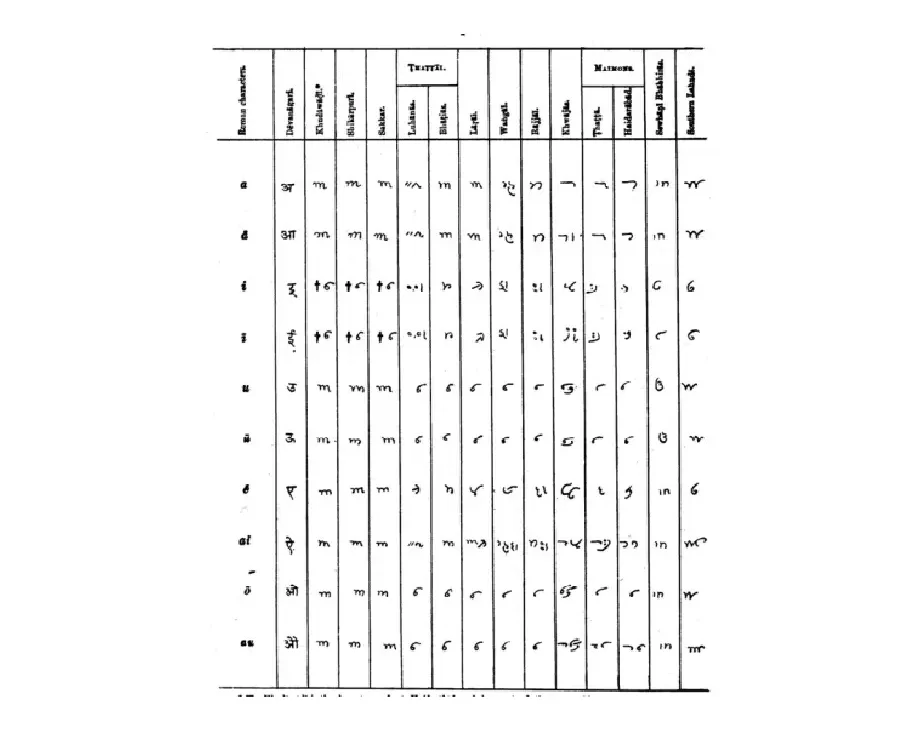
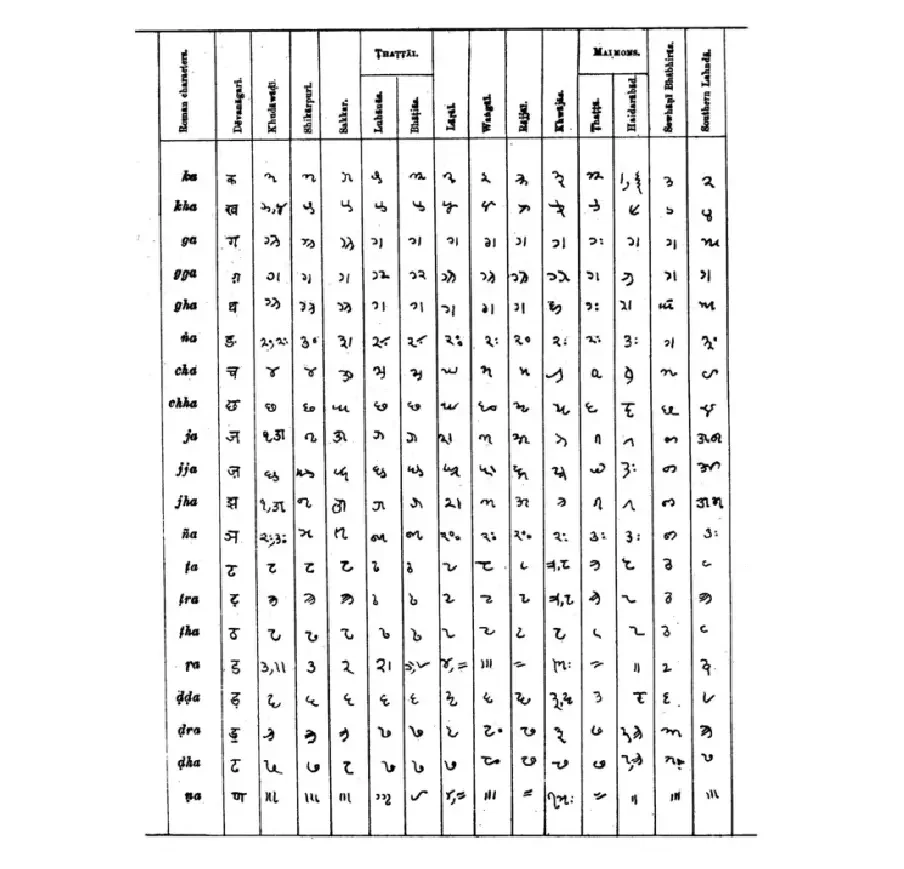 In total Garrison suggested 13 scripts being used in various parts of Sindh but an insight into the scripts show striking similarity among them. A close analysis of Socio-Political conditions prop up multiple reasons for the variations of the Landa based Waranki scripts. A) Ever Since the fall of Maharaja Dahir Sindhi Language was shunted out for Arabic or Persian Languages. Even Arabic Sindhi Scripts used by Muslims till the advent of British lacked consistency. With practically no support from Muslim rulers Sindhi was reduced to almost a Spoken Language. Hindus in Sindh used to write in Sindhi only to the extent of maintaining business accounts. B) There was a tendency among Sindh’s Business class to modify the script as they wished as Hindu Businessmen tend to modify it in order to codify the language a bit as it is normally done today for secrecy; C) Hindus pundits who used us teach Waranki made very little attempt to implement some form of standardization in Scripts across Sindh. D) Since no literature used to be written in this script it was merely reduced to a Mercantile script in the Pre-British days, Arabic was the official language. Among Hindus who used to work under Muslim rulers had to learn the Arabic & Persian mandatory. The business class however continued with the home grown scripts and lack of knowledge of these scripts among ruling Muslim class if fact benefited them. Among the various reasons on why Muslim rulers started the policy of recruiting Hindus was latter knowledge of Hindu scripts as it was called in those days. Situation in the context of script however changed once British occupied Sindh and Sindhi was reinstated as sole official Language of Sindh. Under British rule all Government officers (both British & non Sindhi Indians) to clear an exam on Sindhi mandatorily before being recruited to work in Sindh. As expected Script become an issue in Sindh. Although Hindus in committee set up for the standardization of Script opted for Devanagri a parallel movement started to recognize Warenki/Khudabadi as the standard Sindhi Script. SindhSanskar Sabha, Hyderabad Sindh had been the frontal organization leading the moment for acceptance of such script, Coincidentally in 1867 while Sindh was still a part of Bombay Presidency a Script based of Waranki was put forward. The creator of the script was none other than deputy Inspector of Education Mr. Nayayan Jagarnath Vaidya. The script was a modified version of Khudabadi version of Waranki and some admixture of Shikarpuri version. Termed as Hindu-Sindhi or Hindi Sindhi, the script cleared the issue with vowels – a major drawback of its previous versions.
In total Garrison suggested 13 scripts being used in various parts of Sindh but an insight into the scripts show striking similarity among them. A close analysis of Socio-Political conditions prop up multiple reasons for the variations of the Landa based Waranki scripts. A) Ever Since the fall of Maharaja Dahir Sindhi Language was shunted out for Arabic or Persian Languages. Even Arabic Sindhi Scripts used by Muslims till the advent of British lacked consistency. With practically no support from Muslim rulers Sindhi was reduced to almost a Spoken Language. Hindus in Sindh used to write in Sindhi only to the extent of maintaining business accounts. B) There was a tendency among Sindh’s Business class to modify the script as they wished as Hindu Businessmen tend to modify it in order to codify the language a bit as it is normally done today for secrecy; C) Hindus pundits who used us teach Waranki made very little attempt to implement some form of standardization in Scripts across Sindh. D) Since no literature used to be written in this script it was merely reduced to a Mercantile script in the Pre-British days, Arabic was the official language. Among Hindus who used to work under Muslim rulers had to learn the Arabic & Persian mandatory. The business class however continued with the home grown scripts and lack of knowledge of these scripts among ruling Muslim class if fact benefited them. Among the various reasons on why Muslim rulers started the policy of recruiting Hindus was latter knowledge of Hindu scripts as it was called in those days. Situation in the context of script however changed once British occupied Sindh and Sindhi was reinstated as sole official Language of Sindh. Under British rule all Government officers (both British & non Sindhi Indians) to clear an exam on Sindhi mandatorily before being recruited to work in Sindh. As expected Script become an issue in Sindh. Although Hindus in committee set up for the standardization of Script opted for Devanagri a parallel movement started to recognize Warenki/Khudabadi as the standard Sindhi Script. SindhSanskar Sabha, Hyderabad Sindh had been the frontal organization leading the moment for acceptance of such script, Coincidentally in 1867 while Sindh was still a part of Bombay Presidency a Script based of Waranki was put forward. The creator of the script was none other than deputy Inspector of Education Mr. Nayayan Jagarnath Vaidya. The script was a modified version of Khudabadi version of Waranki and some admixture of Shikarpuri version. Termed as Hindu-Sindhi or Hindi Sindhi, the script cleared the issue with vowels – a major drawback of its previous versions.
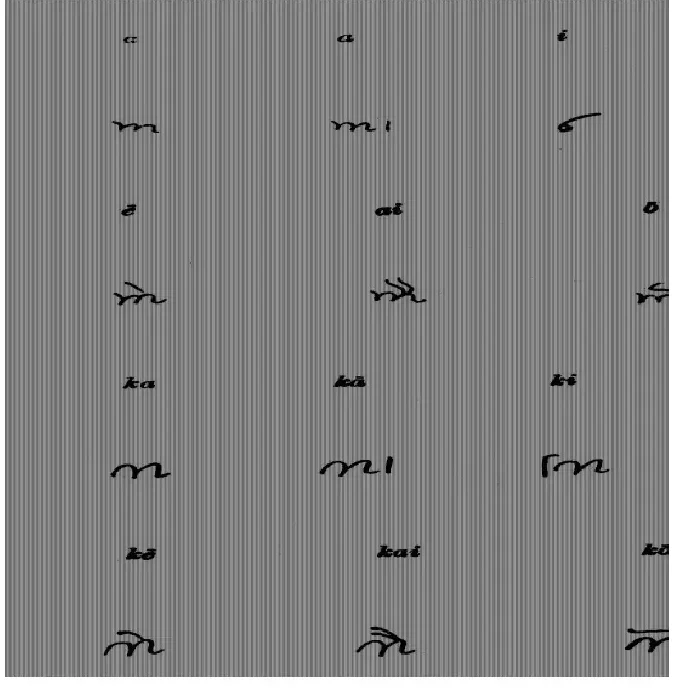
The British Government not only initiated Primary Education in this script but even started maintaining lower court records in the script. In the days & months even Sindhi Literature started to appear in this script. The first book in modified Hindu Sindhi was of Folk tale of Dodo Chaneser and in 1899 the first Sindhi literary magazine “Sukhri” came up. The popularity of the script could be measured by the fact that Sindh Bible society published its sermons of St. Matthew too in this script.
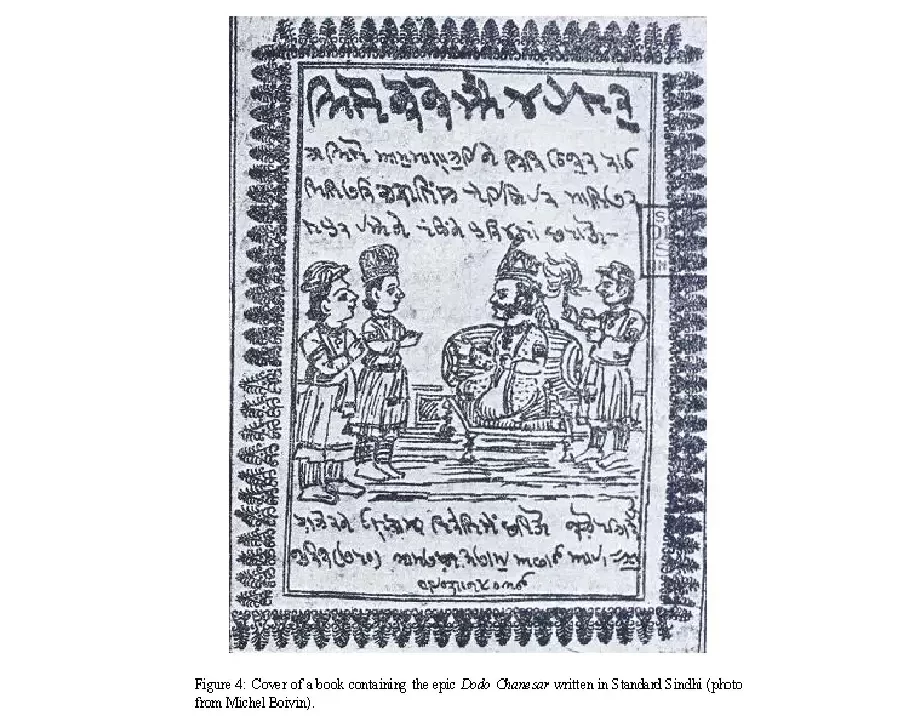
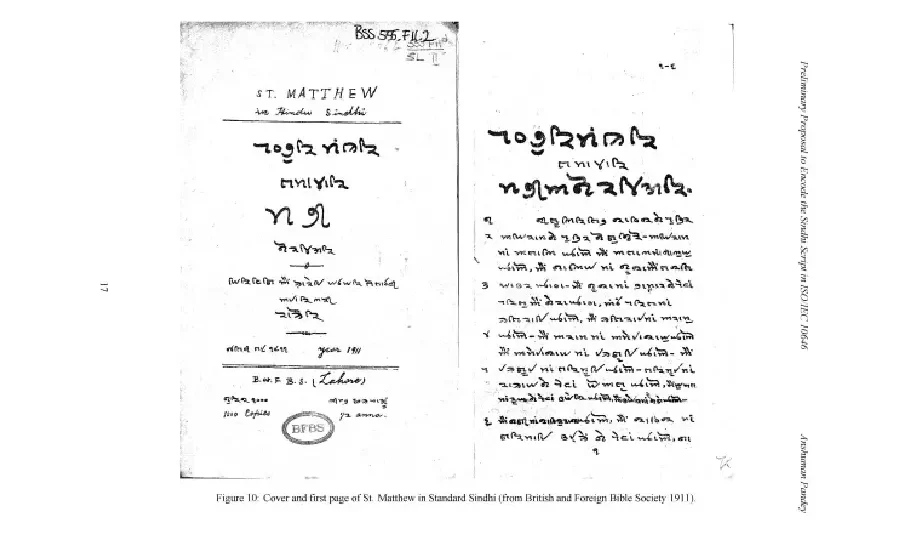 Unfortunately the golden days of the Hindu-Sindhi Script did not last long. The way Sharda script was opposed in Kashmiri Muslims Waranki too was bitterly opposed by Muslims in Sindh. Coincidently for the same reason that so called Brahmi based scripts cannot accommodate muslin vocabulary. Muslims in Sindh oppose not only Waranki but Devanagri as well based on same logic. A close analysis of script vis-a-vis Sindhi communities as existed in Sindh however brings to fore a different prospective. Another Brahmi based scripts was in vogue in Sindh which haven’t been talked about significantly viz Khojki. The word Khojki comes from Persian work “Khwaja” meaning Master. This script was a modified version of Lohanki script with additional marks to express Persian / Arabic words. Compared to Khudabadi or any other formats which were used for Business purpose Khojki was used for writing religion teaching of Ismaili sect among Muslims. Spread across Sindh, Kutch & Kathiawar (in present day Gujarat) this script was widely employed to spread religions teaching and have found its way across multiple states. Legend says writings of Ismaili Muslims were kept secret and the access was limited to few followers for years and that is how this script eventually survived the turbulent Islamic rule in Sindh. This script only showed up in latter part of 19 & early 20.Century.
Unfortunately the golden days of the Hindu-Sindhi Script did not last long. The way Sharda script was opposed in Kashmiri Muslims Waranki too was bitterly opposed by Muslims in Sindh. Coincidently for the same reason that so called Brahmi based scripts cannot accommodate muslin vocabulary. Muslims in Sindh oppose not only Waranki but Devanagri as well based on same logic. A close analysis of script vis-a-vis Sindhi communities as existed in Sindh however brings to fore a different prospective. Another Brahmi based scripts was in vogue in Sindh which haven’t been talked about significantly viz Khojki. The word Khojki comes from Persian work “Khwaja” meaning Master. This script was a modified version of Lohanki script with additional marks to express Persian / Arabic words. Compared to Khudabadi or any other formats which were used for Business purpose Khojki was used for writing religion teaching of Ismaili sect among Muslims. Spread across Sindh, Kutch & Kathiawar (in present day Gujarat) this script was widely employed to spread religions teaching and have found its way across multiple states. Legend says writings of Ismaili Muslims were kept secret and the access was limited to few followers for years and that is how this script eventually survived the turbulent Islamic rule in Sindh. This script only showed up in latter part of 19 & early 20.Century.
A Comparative study of Khojki with Warenki/Khudabadi, Gurumukhi & Devanagri proves that the script was much ahead of Waranki and had the potential to even replace Waranki however that never happened and Sindhi Language remain captive of foreign scripts.
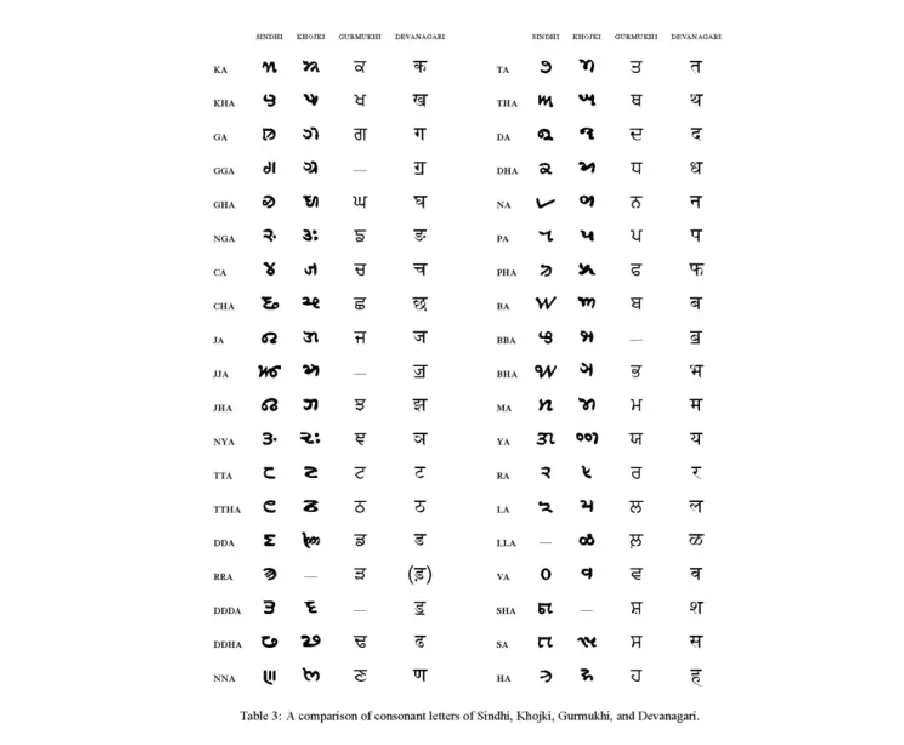
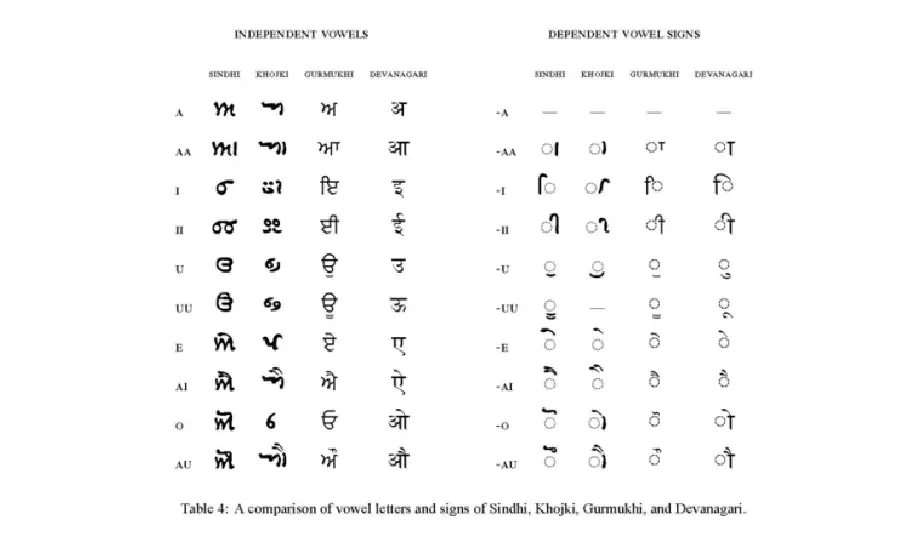
The figures below clearly demonstrate the power of Khojki.
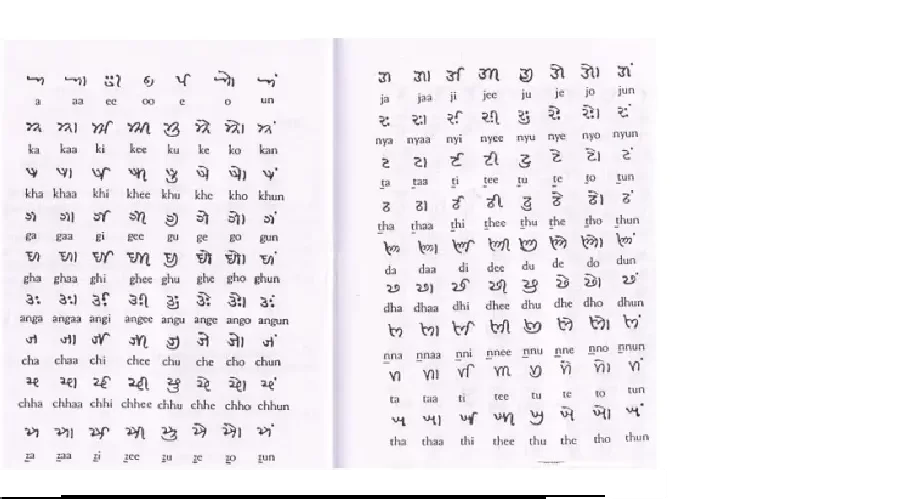
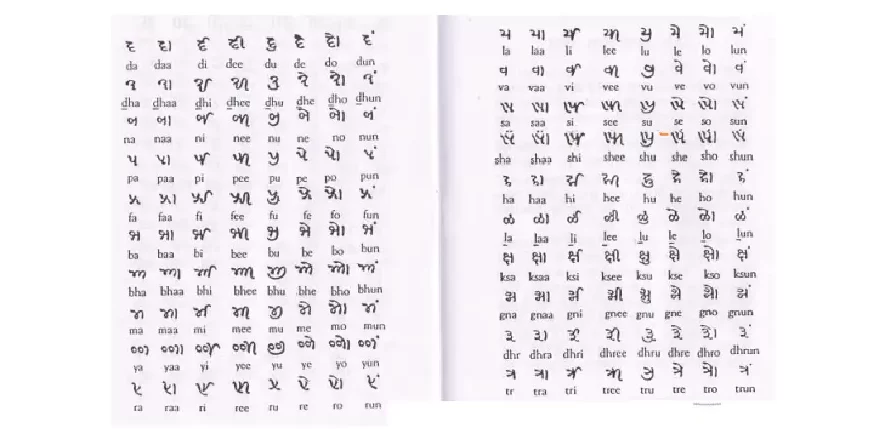
As regards the Status of Landa depended Brahmi based script in Sindh & Punjab, the scripts that comes closest of all non Landa scripts in Takri. Takri was initially widely used in Southern Kashmir & Himachal Pradesh for writing the so called Pahari (Mountain) Languages before being eventually replaced by Devanagri. The study of Takri clearly demonstrated its similarity with Landa especially its Vowel signs. Moreover since till the time of Maharaja Dahir the border of Sindh touch Southern Kashmir which make one believe that in ancient times Sindhis & Kashmiri might had a very close relationships.
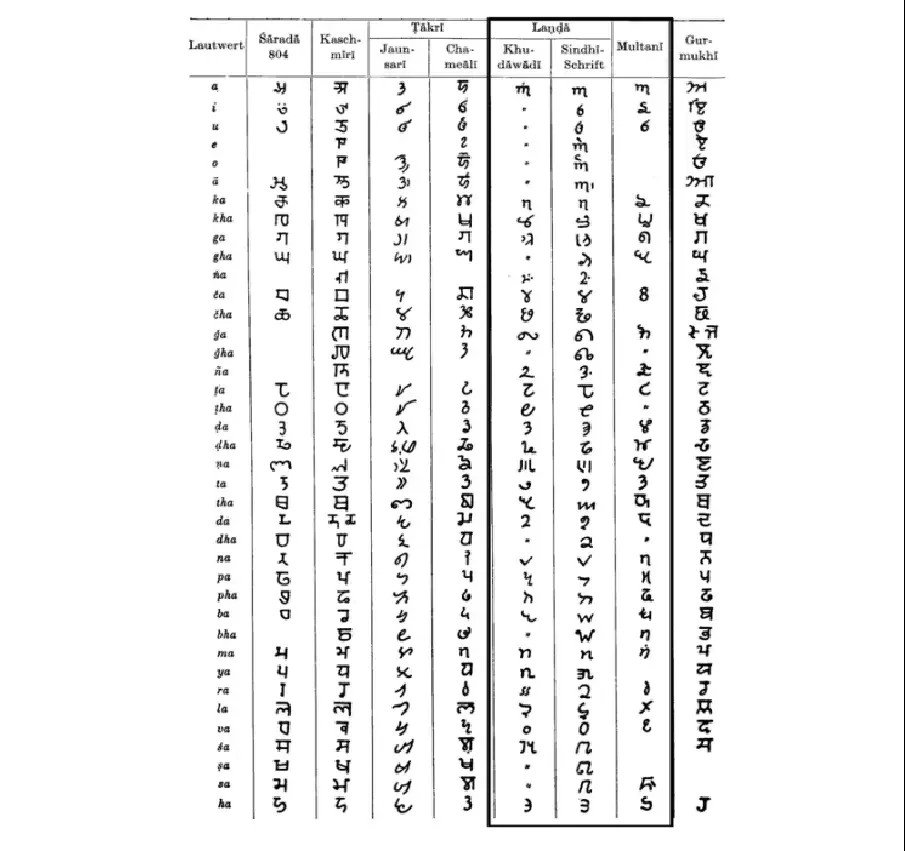 Till 1947 Hindus could not convince Muslims to agree of Khojki or Khudabadi scripts. One prime reason being that Muslim always see any Indian brahmni based scripts as “Hindu” Scripts. It was even difficult in Sindh considering that Muslims had been using a form of corrupted Arabic- Persian Script. Although not perfect the script had a large following and it was unlikely that they would have accepted. The socio-Political conditions in British Sindh too did not support such acceptance considering that in Sindh Muslims as community drifted towards what is referred as their Arabic roots.
Till 1947 Hindus could not convince Muslims to agree of Khojki or Khudabadi scripts. One prime reason being that Muslim always see any Indian brahmni based scripts as “Hindu” Scripts. It was even difficult in Sindh considering that Muslims had been using a form of corrupted Arabic- Persian Script. Although not perfect the script had a large following and it was unlikely that they would have accepted. The socio-Political conditions in British Sindh too did not support such acceptance considering that in Sindh Muslims as community drifted towards what is referred as their Arabic roots.
A close analysis of Landa script had a remarkable feature in Sindh & Punjab. Both the flavors might have a common origin but when it came to development have been on different angles. Another major difference has been the case of Gurumukhi. Which Sikhs in Punjab transformed Punjabi Landa into Gurmulki in Sindh Landa remain in the first stage and could not proceed much. Incidentally in Northern Sindh Gurumukhi was even used to Write Sindhi. Popularity of Gurumukhi in writing Sindhi was such that even Capt. George Stack even considered as toe more adaptable to Sindhi words than Devanagri. However surprisingly it may seem but Sindhis never used their version of Landa but were open to the use of Punjabi Landa aka Gurumukhi. A close analysis of Landa (both of Sindh & Punjab), Takri and Sharda shows remarkable similarity between the scripts which re-established the fact that Sindh, Punjab & Kashmir including Jammu & Himachal Pradesh shows close proximity to with each other and significantly it reinforces the belief that Both Sindhi script (Waranki) and Gurumukhi might have a common ancestry in Sharda.
Takri-Gurumukhi- Landa comparison
In Sindh Waranki (or Khojki) could not make any return to glorious days. Some linguistic believe it could never been possible though. Majority Muslim Sindh would never have accepted any Brahmni based script. Needless to say even if British had accepted Warenki or Devanagari Script as an official script of Sindhi Language, there was a real likelihood of Muslims in Sindh of accepting Urdu (considered de-facto language of Muslims in British days) as sole official Language of Sindh just as Muslims did in Pre-Partition Punjab & Kashmir. For the Hindus in Sindh they hardly any other choice then to accept a modified Perso-Arabic script for Sindhi. Had they not accepted there was near certain likelihood that Sindhi language would have suffered in Sindh massively but Sindhi Hindus made huge blunders in India by insisting upon Arabic script as the official script of Sindhi Language. Post migration Sindhis got an excellent opportunity to clean up the mess regarding the script but internal divisions among Sindhis in the name of Scripts insured that they lost the opportunity. The irony is that Sindhis fought among themselves on the scripts viz Arabic & Devanagari while their own indigenous languished in the sidelines. While Hindu Sindhis got entangled in a pitched battle there was a parallel movement to revive Khudabadi Script as the sole script of Sindhis in India. Pandit Kishanchand Jetley of Pune not only devoted himself for the propagation of Waranki script and had devoted both time and effort to remove the imbalances in terms of vowel errors in Warenki/Khudabadi Script. He was the pioneer in equating Waranki script to that of Script of Harrapa & Mohen-jo-daro. One may recall the fact that Mohen jo Daro script having some sort of link with the ancient Brahmi Script have been collaborated by well know linguistic Mr. Suniti Kumar Chatterjee.
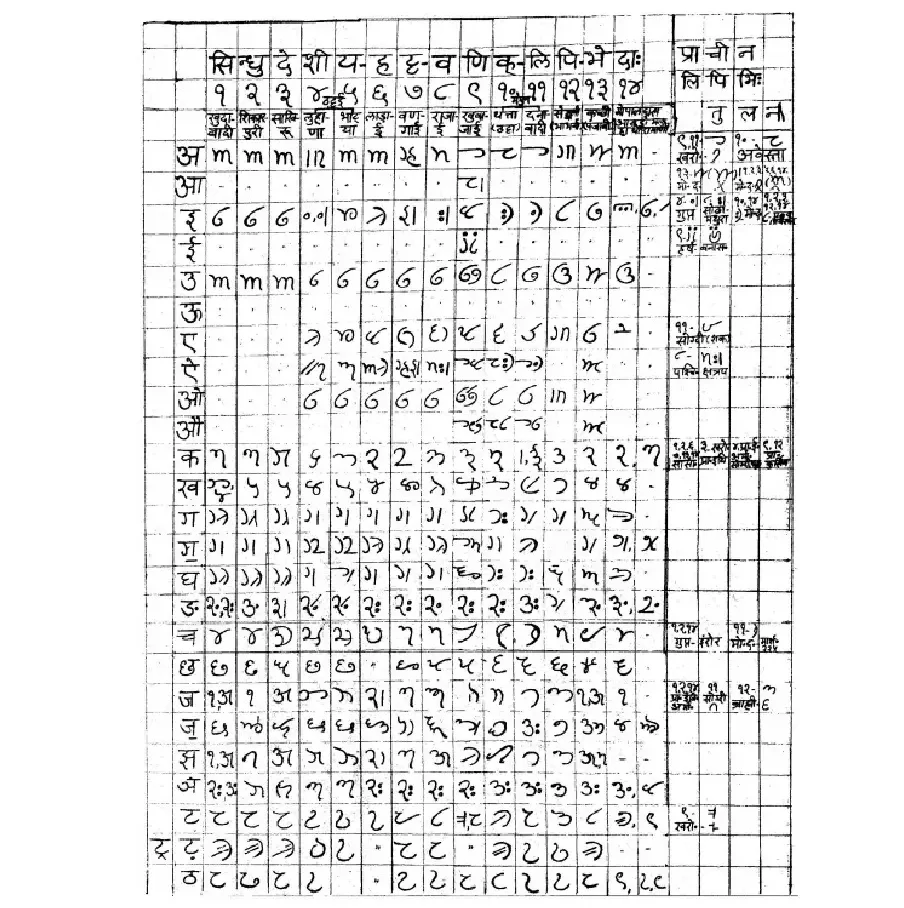
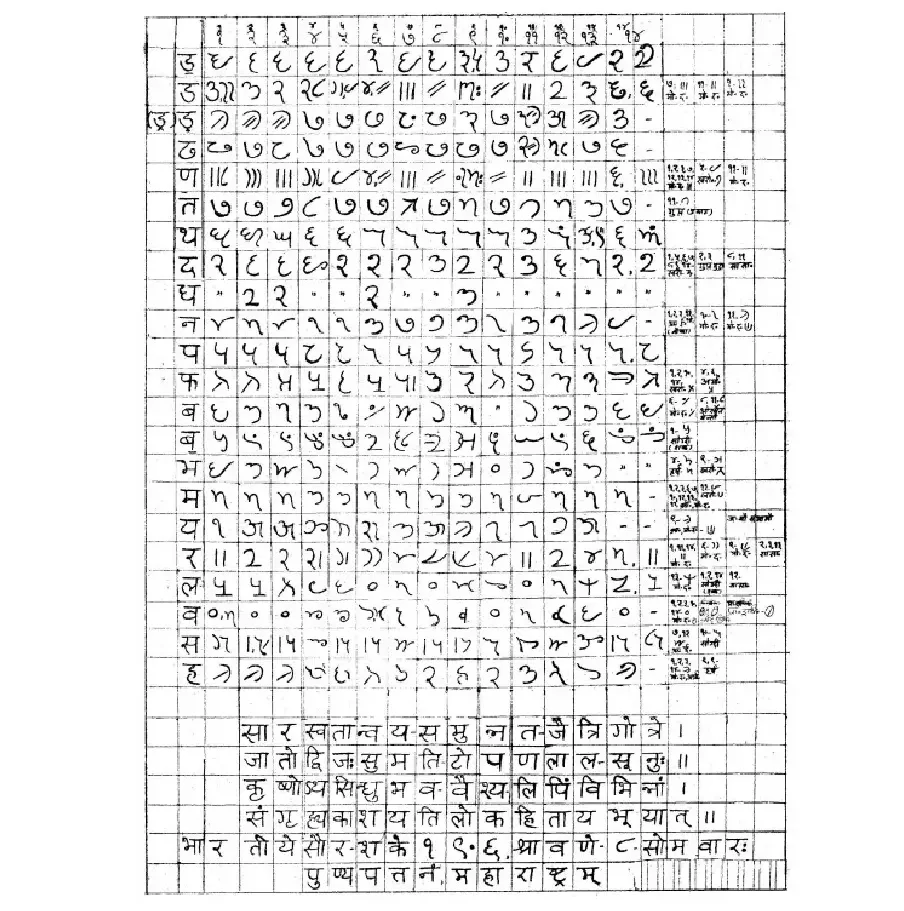 Had Sindhi Hindu community accepted either Khudabadi or even Khojki it would have said goodbye to all wangling on the script issue. Sindhis could have put to rest the issue of script controversies and more significantly it would provide very clear direction to its younger generation the way to go and an understanding to feel their roots. But unfortunately that never materialized and conclusively insured that Sindhis younger generation continue have to drag on with a legacy (Arabic Script) which most feel has been thrust upon them. One may say Sindhi community last a golden opportunity to clear the mess created by 1300 years of Islamic Rule ever since the fall of Sindh to Arab Muslim Invaders.
Had Sindhi Hindu community accepted either Khudabadi or even Khojki it would have said goodbye to all wangling on the script issue. Sindhis could have put to rest the issue of script controversies and more significantly it would provide very clear direction to its younger generation the way to go and an understanding to feel their roots. But unfortunately that never materialized and conclusively insured that Sindhis younger generation continue have to drag on with a legacy (Arabic Script) which most feel has been thrust upon them. One may say Sindhi community last a golden opportunity to clear the mess created by 1300 years of Islamic Rule ever since the fall of Sindh to Arab Muslim Invaders.
Contrary to the popular belief among many Devanagari sympathizers, Devanagari was never used for writing Sindhi till the advent of British. Despite the fact that Hindus in Sindh were well aware of Devanagari Script. Devanagari in Sindh till the advent of British always considered a script exclusively for reading Hindu religious scriptures. Writings of Hindu scriptures in Vernacular Sindhi started late after the advent of British and an end of Islamic rule in Sindh.
By the time British occupied Sindh most of the British officers were fully aware of Devanagari. Both Earnest Trump & George Stack wrote in Devanagari and promoted it too. Incidentally among the various script employed for Sindhi Devanagri need just to add for additional four letters peculiar to express Sindhi Sounds. Sindhi being the genuine daughter of Prakarit/Sanskrik hardly needs any major changes to write Sindhi. However it is strive of separate identity of the scripts that had prompted many and continue to promote many Khudabadi script as has the base of Gujarati and Gurumukhi languages these days.
Unfortunately there had been a Indian Sindhi reluctance in embracing their roots when it comes to Script. Ever since the script crisis way back in 1842 with the advent of British both Hindus and Muslims tend to pick up already know script which implied that neither Arabic or Devanagri could permanently settle the script issue once for all. In the last 65 years which Sindhi Arabic users in India have gone down rapidly there haven’t been the proportional rise of Devanagri users which implies that newer generation have been avoiding Sindhi to a great extent although Devanagri remains a popular script among Hindu Sindhis in India.
To counter the rapid rise of Devanagri Sindhi yet another script is put forward & promoted by a group of Sindhi writers who previously being the vocal critic of Devanagri Sindhi. There had been some well-orchestrated programs to promote Sindhis in Roman Script citing the reason that Sindhis stay in more than 60 countries although India is the only country where Sindh is an officially recognized national language- This despite the fact that such attempt among migrated Kashmiri Pundits have failed miserably. In fact in India none of the attempt of writing any Indian Language every succeeded the reason being that Roman characters are largely considered unfit for expressing Sanskrit based words in Indian Language.
Fortunately the case of Waranki is not lost. With Unicode giving a new life to vernacular Languages world-wide significant work had been done in almost forgotten South Asian Script by Angshuman Pandey. Both the Sindhi scripts of Khudabadi & Khojki have made significant progress in their pursuit of being eventually coded for Unicode. The coding once eventually implemented is likely to give a new lease of life and will bring up the issue invariable.
If Sindhi Language has to survive among Hindu Sindhis then the script tangle has to be resolved. Languages don’t survive with multiple scripts. Multiple scripts among to close knit communities creates confusions which ultimately leads to confused newer users/ generation and that is what invariably happened to Sindhi. Among the various scripts being used for Sindhi only Khudabadi or for that matter Khojki enjoys the distinction of not only expressing all the Sindhi sounds in its original form but provide a sense of distinct Sindhi identify who no other scripts but the question remains for Sindhis in India and abroad is are we ready to take the plunge?
____________________
Courtesy: Academia (The article was posted on June 6, 2013)
[The author of this article has used the word ‘Waranki’, however the correct word is ‘Wanki’]